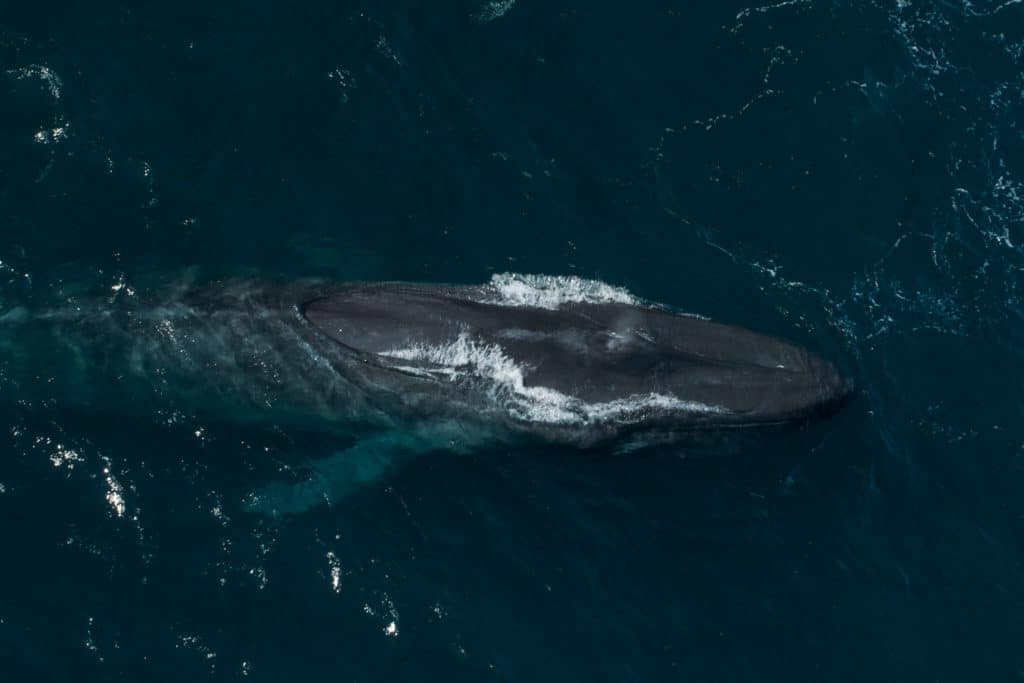Blue whales are the largest animal to ever have existed on this planet. As large as roughly three school buses, and as heavy as fifteen, these beautiful animals outsize the dinosaurs.
Due to their gigantic size, it would be easy to assume that these whales are slow.
That’s why in this post, we’re going to take a closer look at the blue whale’s speed, and specifically answer a question we see many of our readers asking.
How fast are blue whales?
In short, blue whales typically cruise through the ocean at around 5mph (8km/h) but are able to move at 31mph (49km/h) in short bursts.
Let’s take a closer look…
Are Blue Whales Fast Or Slow?
Blue whales can weigh between 130,000 – 150,000kg (around 190 tons), making them incredibly heavy.
Their weight and size mean they aren’t quite as agile as some other species of whale, but it does give them some serious power behind their tail.
Blue whales can be quite fast when they need to be, when interacting with other whales they can reach impressive speeds of up to 31mph.
Their average traveling speed is around 12mph, whereas when they are feeding, they are typically moving at around 5mph.
This makes the blue whales pretty fast swimmers, but only over short distances when they need to move quickly.
Pulling all of that weight through the water is certainly enough to tire even the largest animal on the planet out after a while.
The Fin Whale is widely regarded as the fastest whale in the ocean, but blue whales are able to swim at similar speeds too.
Why Are Blue Whales Fast?
Due to the blue whale’s size, they have a lot of power behind their tails which they can use to generate power.
Their tail is so large that when it pushes through the water it propels them forwards, allowing them to accelerate quickly too.
They also have two, large pectoral fins that are roughly one foot each, these help the whale gain extra speed when they need to.
The blue whale’s shape is perfectly adapted for allowing them to glide through the water easily. It is shaped like a bullet, and perfectly streamlined for the least resistance possible in the water.
This whale has huge organs which allow it to operate as efficiently as possible. For example, the blue whale’s heart can be the size of a car, ensuring it can pump blood through its body at all times.
They also have huge lungs that allow them to inhale a lot of oxygen, which can keep them moving at a pace for a fair distance.
All of these amazing attributes combined allow the blue whale to move at impressive speeds when it needs to.
Can Blue Whales Escape Predators?
For the most part, blue whales are simply too large to have predators. They are also filter feeders, so are not active predators themselves.
Can you imagine if these magnificent whales were predators? The ocean would be a much more terrifying place, for everyone and everything involved.
The only known predator to even attempt to take down a blue whale is the Orca, a formidable hunter that typically hunts in pods.
Orca are able to swim at speeds of 56kmh, which is a little faster than the blue whale. This means the blue whale often can’t escape Orca and instead has to defend itself.
Orca are incredibly smart animals that work together to surround the blue whale and then make the kill.
Oftentimes if the blue whale is traveling with young, the Orca will target the young specifically as they know the chances of taking out an adult blue whale are slim.
After the Orca has blocked the whale’s escape, they will continuously take bites out of the whale’s blubber until it becomes too weak to escape.
They are relying on the blue whale to become exhausted and essentially give up the fight.
That said, these attacks are rare. Orca have a much better chance at taking out prey that is a little more their size, as many times their blue whale hunts are unsuccessful.
Adult blue whales do defend themselves against Orca, they will use tail slaps to injure the Orca, and a slap from a tail of the size could seriously injure anything it hits.
Final Thoughts
So, how fast are blue whales? Pretty fast! Around 5mph when feeding, 28 – 31mph in short bursts, and 12mph whilst traveling.
Although these whales are gigantic, they can generate some serious power when they want to and use their large tail to get up to some impressive speeds.
They typically have no natural predators so usually don’t need to swim at maximum speeds, however, they have been known to swim at these speeds when interacting with other whales.
The blue whale is a magnificent animal, and witnessing one in the wild is a breathtaking experience that is something that stays with you forever.
If you ever get the opportunity to witness a blue whale, I hope you take it.
Thanks for taking the time to read this post and I hope you’ve learned something new today about the speed of blue whales.
If you have enjoyed this post, feel free to stick around and learn more about whales and other marine wildlife.

Hi, I’m George – the founder of MarinePatch. I created this blog as marine wildlife has been my passion for many years. I’ve spent over a decade in the marine wildlife industry and spent years out in the field conducting research. In today’s modern world, an online blog is the best place for me to share my findings and reach as many people as possible to help educate and inspire others. Enjoy your time here and you’re welcome back anytime!

